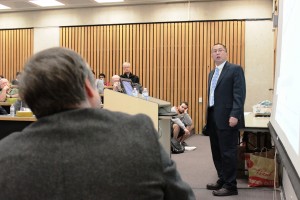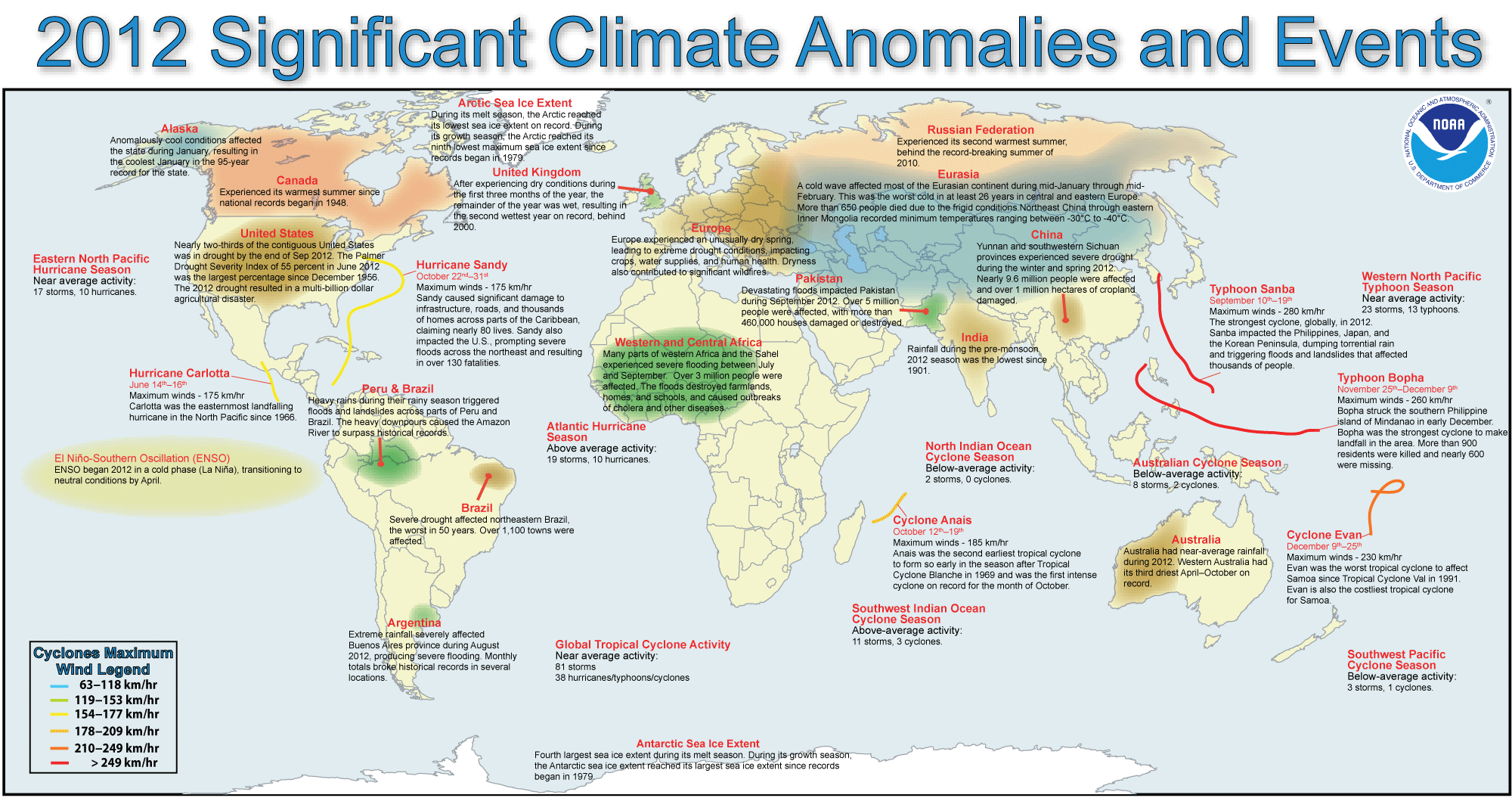2012 Significant Climate Anomalies and Events; Chief of US Pacific Forces Calls Climate Biggest Worry; Retired NASA Scientists Misunderstanding Climate; 2012 Billion Dollar Disasters in the US
2012 Significant Climate Anomalies and Events
2012 Significant Climate Anomalies and Events
Global Highlights
- The year 2012 was the 10th warmest year since records began in 1880. The annual global combined land and ocean surface temperature was 0.57°C (1.03°F) above the 20th century average of 13.9°C (57.0°F). This marks the 36th consecutive year (since 1976) that the yearly global temperature was above average. Currently, the warmest year on record is 2010, which was 0.66°C (1.19°F) above average. Including 2012, all 12 years to date in the 21st century (2001–2012) rank among the 14 warmest in the 133-year period of record. Only one year during the 20th century—1998—was warmer than 2012.
- Separately, the 2012 global average land surface temperature was 0.90°C (1.62°F) above the 20th century average of 8.5°C (47.3°F) and ranked as the seventh warmest year on record.
- La Niña, which is defined by cooler-than-normal waters in the eastern and central equatorial Pacific Ocean that affect weather patterns around the globe, was present during the first three months of 2012. The weak-to-moderate La Niña dissipated in the spring and was replaced by ENSO-neutral conditions for the remainder of the year. When compared to previous La Niña years, the 2012 global surface temperature was the warmest observed during such a year; 2011 was the previous warmest La Niña year on record. When compared to previous La Niña years, the 2012 global surface temperature was the third warmest observed during such a year, behind 2006 and 2009, which are currently tied for warmest.
- The 2012 global average ocean temperature was 0.45°C (0.81°F) above the 20th century average of 16.1°C (60.9°F) and ranked as the 10th warmest year on record. The three warmest annual ocean surface temperatures occurred in 2003, 1998, and 2010—all warm phase El Niño years.
- Following the two wettest years on record (2010 and 2011), 2012 saw near average precipitation on balance across the globe. However, as is typical, precipitation varied greatly from region to region.
Source: https://www.ncdc.noaa.gov/sotc/global/2012/13
Chief of US Pacific Forces Calls Climate Biggest Worry
By Bryan BenderGlobe Staff March 09, 2013
Navy Admiral Samuel J. Locklear III, in an interview at a Cambridge hotel Friday after he met with scholars at Harvard and Tufts universities, said significant upheaval related to the warming planet “is probably the most likely thing that is going to happen . . . that will cripple the security environment, probably more likely than the other scenarios we all often talk about.”
“You have the real potential here in the not-too-distant future of nations displaced by rising sea level. Certainly weather patterns are more severe than they have been in the past. We are on super typhoon 27 or 28 this year in the Western Pacific. The average is about 17.”
Source: Boston Globe
Retired NASA Scientists Enter Climate Change Fray
A group of retirees from NASA who once put a man on the moon and call their group The Right Climate Stuff “shouldn’t be taken seriously” according to an article in The Guardian, a British newspaper.
Doiron said he looked at the climate models that such fears are based on and felt they couldn’t be believed. After all, he said at NASA he’d used computer models to develop the landing gear for the lunar module and knows a thing or two about them.

Dave Fehling / StateImpact
Dr. Willie Soon at a climate change debate at the University of Houston Law Center. Dr. John Nielson-Gammon (back to camera) awaits his turn. Listen to them in our Radio Story.
“So we validated the model before we used it for any design decisions. And the current climate models are not validated,” Doiron said. “I don’t think we’re using anything close to a rational process to deal with this concern about global warming. The politicians, at least those in leadership, are acting like it’s a proven thing, that (carbon dioxide) is causing global warming, but it’s not been scientifically proved.”
Doiron is headed back to Washington. On Friday he’s slated to be on a panel to talk about “The Right Climate Stuff” at the Conservative Political Action Conference (CPAC).
Dorian’s mistake. It’s a basic scientific tenet. Correlation is not causation. Just be cause their models were terribly flawed does not mean that all models are terribly flawed. This is a very common mistake made by people that do not understand that facts used out of context are less or even irrelevant.
Source: https://stateimpact.npr.org/texas/2013/03/12/retired-nasa-scientists-enter-climate-change-fray/
2012 Billion Dollar Disasters in the United States
Source https://www.ncdc.noaa.gov/billions/summary-stats
Ten Times More Hurricane Surges in Future, New Research Predicts
Mar. 18, 2013 — By examining the frequency of extreme storm surges in the past, previous research has shown that there was an increasing tendency for storm hurricane surges when the climate was warmer. But how much worse will it get as temperatures rise in the future? How many extreme storm surges like that from Hurricane Katrina, which hit the U.S. coast in 2005, will there be as a result of global warming? New research from the Niels Bohr Institute show that there will be a tenfold increase in frequency if the climate becomes two degrees Celsius warmer.
Source: https://www.sciencedaily.com/releases/2013/03/130318151519.htm


